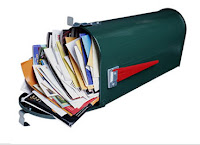Jack Nicholson.
Do you remember when the experts said ‘bricks and mortar are dead’ because everyone would be shopping online?
‘They’ have been saying that for over ten years now and I’m finding that my local supermarket is still filled with shoppers. How about you? Oh sure, e-commerce has changed the way that we shop, but retail is still alive and kicking (and it isn’t because people don’t know that they can buy online). How is this possible? Well, lots of reasons but three of the biggest are:
a) Change (even welcomed change) is very difficult.
b) Shopping is still a popular activity.
c) There are items people still want to touch, see and try before they buy.
d) The big one: people want immediate gratification – I’ve simply got to have the item now!
What about direct mail, is that dead? Nope. According to DM News, income from direct mail is expected to grow 5.8 per cent to 47.8 billion in 2011.

Has it changed? Yes it has and in a really good way. Junk mail has declined, mostly because mailer
s are becoming smarter by targeting better. So you’re seeing less mail in your mailbox but what you do see is more relevant. Think about how that information can help set your organisation’s next piece of direct mail apart.
Email marketing? Oh yes, I recall when the spam laws were going to destroy email marketing. Did they? Nope. According to Pew’s latest research, 90-100 per cent of every generation from millennials (those born after 1985 who have grown up with the Web and who are now entering the jobs market, higher education and the electorate) to the silent generation (people born between 1925 and 1945) use email. And even though we gripe and moan about it, it still works – if it gets opened. That means putting together a strategy for acquiring email addresses and putting some thought and effort into creating attention-grabbing subject lines and a compelling message. What is dead is the easy ‘send anything’ emails that were popular circa 2001.
Now social media is dead. Really? Someone must be sleeping under a rock to completely miss all the media attention Facebook is getting (heck, the movie alone has won more than a few awards). Is it being over-used and over-populated? Sure, but just like retail, direct mail and email this is a natural progression of business. Come to think of it, the same thing happened with the gold rush – a new frontier was discovered to have gold and early adapters collected the easy gold. Others saw this and rushed in and soon someone declared the gold rush was dead.
Now have you taken a look at the price of gold in the current market? It’s experiencing record highs. So, perhaps you can’t get rich just panning for gold but there are lots of companies that have adapted and are using sophisticated equipment to make money in the harder to reach but still well alive gold market.
There is a lesson to be learned here. Are direct mail, email, and social media dead? Keep buying into that so that my clients and other organisations ‘in the know’ can keep these gold mines all to ourselves.
Seriously, what should you do? Use every media that you can afford ... and get strategic about how you use it.
Take a cue from my friend John Lepp of Agents of Good, ‘Donors don’t give to the channel. They give to the campaign. Give your donors a reason to care, be frank with what you want, tell them how they will help, spread across channels evenly and you will win.’
Sound, donor-centric fundraising is not and will never be an overnight process. Before you dismiss a medium spend some time learning its finer points and developing a strategy for how you can apply age-old tried and true concepts to the new.
